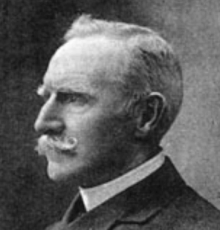
Edmund Kirby was born in Liverpool, England on 8 April 1838 and was a pupil of Edward Welby Pugin (1834-1875) in London. He also attended the Royal Academy Schools in London. He was an assistant to John Douglas (1830-1911) in Chester before commencing independent practice as an architect in Birkenhead in c.1863. By 1866 he had relocated the practice to Liverpool.
In 1905 he formed a partnership with his sons Francis Joseph Kirby (1873-1945) and Edmund Bertram Kirby (1881-1953) as Edmund Kirby & Sons. They in turn took over the running of the practice following their father's retirement in 1917.
Kirby worked mainly in North-West England. He was a follower of the Roman Catholic faith and most of his many ecclesiastical commissions came from the Roman Catholic Church.
A tabernacle door in copper, silvered and parcel gilt designed by Edmund Kirby and modelled and carved by Conrad Dressler was exhibited in the 2nd exhibition of the Arts & Crafts Exhibition Society in London in 1889.
Edmund Kirby was elected an Associate of the Royal Institute of British Architects (ARIBA) in 1867, and a Fellow of the Royal Institute of British Architects (FRIBA) in 1888. He was also a member of the Liverpool Architectural Society and its President.
Kirby's address was given as Derby Buildings, Fenwick Street, Liverpool in 1868; and Union Buildings, 5 Cook Street, Liverpool in 1880 and 1914. He died in Birkenhead, Cheshire on 24 April 1920.
Architectural projects by Kirby's practice included St Wilfrid's Church in Northwich, Cheshire (1864-66); St Mary's Church in Middlewich, Cheshire (1865); additions to Dee House, on Chester, Cheshire (1867); Dene House in Great Budworth, Cheshire (1868-69); St. Clare's Convent in Pantasaph, Flintshire, Wales (1868-1907); St Mary’s Schools in Dukinfield, near Manchester (1872); Sacred Heart Church, Hindsford, Greater Manchester (1869); St Werburgh's Church in Chester, Cheshire (1873-75); St Gregory's Church in Farnworth, Greater Manchester (1873-75); Blessed Sacrament Church in Walton, Liverpool (1876-78); Redcourt in Prenton, Birkenhead, Cheshire (1876-78); St Thomas' Church in Waterloo, Lancashire (1877); Methodist Church in Weaverham, Cheshire (1878); Union Building, Cook Street, Liverpool (1878); St Michael and All Angels Church in Little Leigh, Northwich, Cheshire (1878-79); Our Lady's Church in Parbold, Lancashire (1878-84); Trident House, Liverpool (1879); Reform Club 31 – 33 Dale St , Liverpool (1879); Mere Hall in Birkenhead, Cheshire (1879-82); Dene Wellhouse in Great Budworth, Cheshire (1880); Midland Bank in Llanrwst, Conwy, Wales (1880); Rathmore in Birkenhead, Cheshire (c.1880); Venice Chambers in Liverpool (1882); Arnot Street Schools in Walton, Liverpool (1884-94); Arnot St School, Liverpool (1885); Church of St Thomas Aquinas and St Stephen Harding in Market Drayton, Shropshire (1886); St. Cross Church in Appleton Thorn, Cheshire (1886-87); Church of Our Lady Star of the Sea in Seacombe, Wallasey, Cheshire (1888-89); St Lawrence's Church in Birkenhead, Cheshire (1889-90); offices and warehouse for Ellis and Company in Liverpool (1889-90); Rainbow House, school board offices in Walton, Liverpool (c.1890); Providence Cottage in Great Budworth, Cheshire (1891); Church Hall, Church of the Holy Name of Jesus in Manchester (1892); St Mary's Catholic Schools in Wrexham, Wales (1893); St John's Church in High Legh, Cheshire (1893); St Hildeburgh's Church in Hoylake, Wirral, Cheshire (1897-99); The York Dispensary in York, Yorkshire (1897-99); houses in Port Sunlight, Cheshire (1899); Holy Name of Jesus Church in Oxton, Birkenhead, Chershire (1899-1900); St Joseph's Church in Tranmere, Birkenhead, Cheshire (1899-1900); Barclay's Bank in Parliament Street, York (1901); St Michael and St James' Church in Haunton, Staffordshire (1901-02); Church of St Peter and St Francis in Prestatyn, Denbighshire, Wales (1903); St Vincent de Paul's Church in Altringham, Lancashire (1904-05); Queen Victoria Monument in Hamilton Square, Birkenhead, Cheshire (1905); Our Lady and the Apostles' Church in Stockport, Cheshire (1905); Manor Road School in Liscard, Cheshire (1905); Edward VII Memorial Clock Tower in Birkenhead, Cheshire (1911); London City and Midland Bank in Birkenhead, Cheshire (1911); and St John the Baptist's Church in Meols, Cheshire (1911-13).
_____
See also:
British Listed Buildings [link below]
Historic England [link below]
Wikipedia. List of works by Edmund Kirby [link below]
Armstrong, Barrie and Armstrong, Wendy. The Arts and Crafts movement in the North West of England: a handbook. Wetherby, England: Oblong Creative Ltd., 2006
Directory of British Architects 1834-1914. Compiled by Antonia Brodie, et al. Volume 1: A-K. London; New York: British Architectural Library, Royal Institute of British Architects/Continuum, 2001
‘Obituary’. The Builder vol. 118, 21 May 1920 p. 598
‘Obituary’. Royal Institute of British Architects Journal vol. 27, 1920 p. 364
‘Obituary’. The Tablet 1 May 1920 p. 602